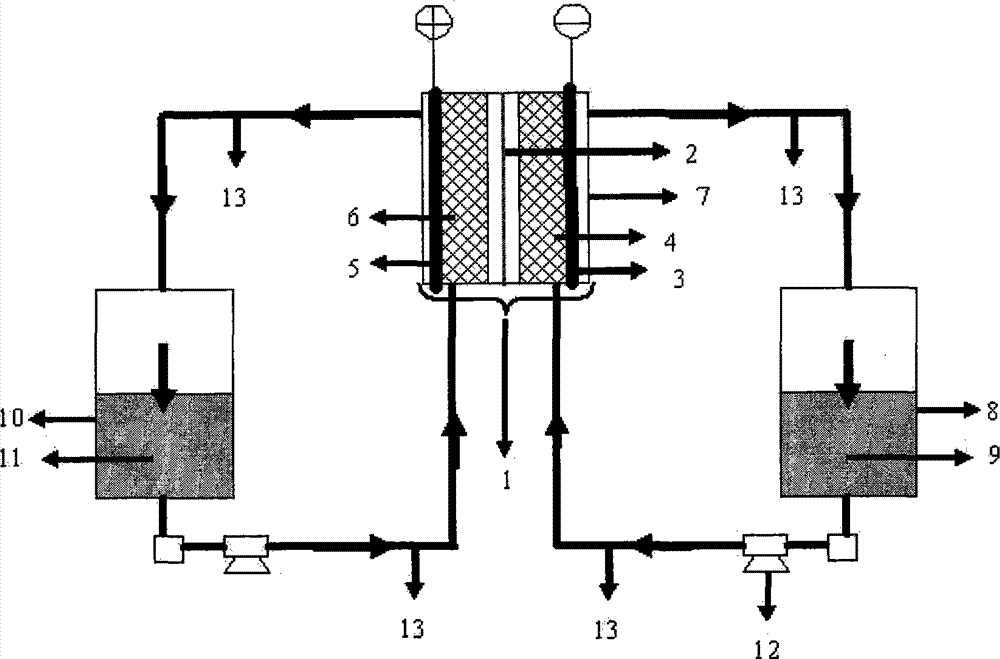Flow battery with negative electrode of titanium pair
A technology of flow battery and anode electrolyte, applied in battery electrodes, regenerative fuel cells, circuits, etc., can solve problems such as low theoretical voltage, precipitation, electrode passivation, etc., and achieve simple manufacturing process, high battery voltage, and cycle life. high effect
- Summary
- Abstract
- Description
- Claims
- Application Information
AI Technical Summary
Problems solved by technology
Method used
Image
Examples
example 1
[0020] Graphite felt is used as the positive electrode, the impermeable graphite plate is used as the positive current collector, the graphite felt is used as the negative electrode, and the impermeable graphite plate is used as the negative current collector. 1.0M TiOSO is used 4 +3M H 2 SO 4 As the negative electrode electrolyte, Nafion117 cation exchange membrane is used as the diaphragm, and 1.0M CoSO 4 +3M H 2 SO 4 As the positive electrolyte, the positive and negative electrodes and the diaphragm are packaged in a shell made of plexiglass to form a single titanium-cobalt flow battery; the negative electrolyte is connected to the magnetic pump and the negative storage tank to form an electrolyte circuit, and the positive electrolyte is also connected with The magnetic pump and the positive storage tank are connected to form an electrolyte circuit. When the solution flow rate on the surface of the positive and negative electrodes is about 10cm / s, at 5mA / cm 2 The avera...
example 2
[0022] Graphite felt is used as the positive electrode, the impermeable graphite plate is used as the positive current collector, the graphite felt is used as the negative electrode, and the impermeable graphite plate is used as the negative current collector. 0.2M TiOSO is used 4 +5M H 2 SO 4 As the negative electrode electrolyte, Nafion117 cation exchange membrane is used as the diaphragm, and 0.2M MnSO 4 +0.2M Na 2 h 2 P 2 o 7 +5M H 2 SO 4 As the positive electrolyte, the positive and negative electrodes and the diaphragm are packaged in a shell made of plexiglass to form a single titanium-manganese flow battery; the negative electrolyte is connected to the magnetic pump and the negative storage tank to form an electrolyte circuit, and the positive electrolyte is also connected with The magnetic pump and the positive storage tank are connected to form an electrolyte circuit. When the solution flow rate on the surface of the positive and negative electrodes is about ...
example 3
[0024] Lead dioxide is used as the positive electrode, lead alloy repeatedly oxidized in sulfuric acid is used as the positive current collector, graphite felt is used as the negative electrode, and impermeable graphite plate is used as the negative current collector. 1.0M TiOSO is used 4 +3M H 2 SO 4 As the negative electrode electrolyte, Nafion117 cation exchange membrane is used as the diaphragm, and 0.5M HIO is used 3 +3M H 2 SO 4 As the positive electrolyte, the positive and negative electrodes and the diaphragm are packaged in a shell made of plexiglass to form a single titanium iodine flow battery; the negative electrolyte is connected to the magnetic pump and the negative storage tank to form an electrolyte circuit, and the positive electrolyte is also connected with The magnetic pump and the positive storage tank are connected to form an electrolyte circuit. When the solution flow rate on the surface of the positive and negative electrodes is about 5cm / s, at 5mA / c...
PUM
 Login to View More
Login to View More Abstract
Description
Claims
Application Information
 Login to View More
Login to View More - R&D
- Intellectual Property
- Life Sciences
- Materials
- Tech Scout
- Unparalleled Data Quality
- Higher Quality Content
- 60% Fewer Hallucinations
Browse by: Latest US Patents, China's latest patents, Technical Efficacy Thesaurus, Application Domain, Technology Topic, Popular Technical Reports.
© 2025 PatSnap. All rights reserved.Legal|Privacy policy|Modern Slavery Act Transparency Statement|Sitemap|About US| Contact US: help@patsnap.com

